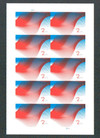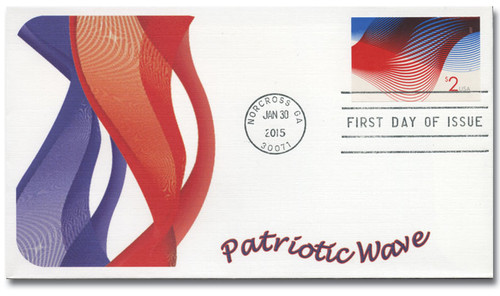
2015 $2.00 Imperf Patriotic Wave
# 4954a - 2015 $2.00 Imperf Patriotic Wave
$10.95 - $109.00
4954a- Imperforate
2015 $2 Patriotic Waves
2015 $2 Patriotic Waves
The red and blue intersecting lines on the Patriotic Waves stamps were designed to look like billowing flags.
Early in the Revolutionary War, colonial ships flew the Red Ensign, a flag then used by British merchant seamen. The Colonies, newly united against the crown, needed a banner to distinguish themselves from the British. The first U.S. Navy Ensign was created in 1775 when white stripes were added to the red field of the British ensign. The Continental Colors, as the flag became known, was soon adopted by the Continental Army as well. It became the first, though unofficial, flag of the United States.
The 13 alternating red and white stripes represented the 13 Colonies. The Union Jack was kept on the flag as a symbol of loyalty to British rule. At the time, most Patriots were not fighting for independence, but simply for fair representation. But as the Revolution progressed, the Colonies grew more distant from mother England. As desire for independence grew, so did the need for a new flag.
In 1777, the Second Continental Congress approved an official flag design based on the Colors. There was one significant difference – the British Union Jack was removed. It was replaced by a blue field dotted with 13 white stars representing “a new constellation.” A nation was born, and with it a symbol of dedication to the liberty of mankind.
U.S. #4954 and the $1 Patriotic Waves stamp (#4953) were designed by Michael Dyer and Antonio Alcalá was the art director. They had previously teamed up on the 2012 Waves of Color stamps (#4717-20).
$2 Patriotic Waves, issued for use on packages and large envelopes
Issue Date: January 30, 2015
Category: Definitive
Printed By: Ashton Potter USA Ltd.
Printed By: Ashton Potter USA Ltd.
4954a- Imperforate
2015 $2 Patriotic Waves
2015 $2 Patriotic Waves
The red and blue intersecting lines on the Patriotic Waves stamps were designed to look like billowing flags.
Early in the Revolutionary War, colonial ships flew the Red Ensign, a flag then used by British merchant seamen. The Colonies, newly united against the crown, needed a banner to distinguish themselves from the British. The first U.S. Navy Ensign was created in 1775 when white stripes were added to the red field of the British ensign. The Continental Colors, as the flag became known, was soon adopted by the Continental Army as well. It became the first, though unofficial, flag of the United States.
The 13 alternating red and white stripes represented the 13 Colonies. The Union Jack was kept on the flag as a symbol of loyalty to British rule. At the time, most Patriots were not fighting for independence, but simply for fair representation. But as the Revolution progressed, the Colonies grew more distant from mother England. As desire for independence grew, so did the need for a new flag.
In 1777, the Second Continental Congress approved an official flag design based on the Colors. There was one significant difference – the British Union Jack was removed. It was replaced by a blue field dotted with 13 white stars representing “a new constellation.” A nation was born, and with it a symbol of dedication to the liberty of mankind.
U.S. #4954 and the $1 Patriotic Waves stamp (#4953) were designed by Michael Dyer and Antonio Alcalá was the art director. They had previously teamed up on the 2012 Waves of Color stamps (#4717-20).
$2 Patriotic Waves, issued for use on packages and large envelopes
Issue Date: January 30, 2015
Category: Definitive
Printed By: Ashton Potter USA Ltd.
Printed By: Ashton Potter USA Ltd.














